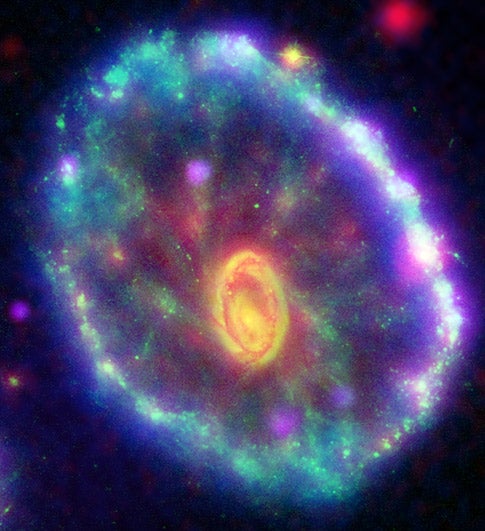Last year, astronomers discovered extended stellar disks around the Andromeda Galaxy and NGC 300. The trend continues: NASA’s ultraviolet-sensing Galaxy Evolution Explorer (GALEX) satellite has revealed a similar disk of faint stars surrounding the famous Cartwheel Galaxy in Sculptor.
The Cartwheel, which lies about 420 million light-years from Earth, is the best known example of a ring galaxy. A brilliant ring gleams with the light of massive, young, blue stars — many weighing 5 to 10 solar masses. Spoke-like formations of older stars appear to connect this bright outer ring with an older inner ring surrounding the galaxy’s nucleus. These features — hub, spoke, and rim — give the galaxy its name.
This unusual arrangement was set in motion about 100 million years ago, when a small galaxy plunged straight through the disk of a normal spiral galaxy and sparked an expanding ring-shape burst of star formation. Thanks to the presence of the outer ring’s many hot, young, massive stars, the Cartwheel is one of the brightest nearby galaxies at ultraviolet wavelengths.
“The dramatic plunge has left the Cartwheel Galaxy with a crisp, bright ring around a zone of relative calm,” says Phil Appleton of the California Institute of Technology in Pasadena, California. Appleton presented his GALEX findings Wednesday at the American Astronomical Society meeting in Washington.
Previously, scientists believed the ring, itself large enough to encircle the Milky Way, marked the Cartwheel’s outermost edge. But Appleton says the latest GALEX observations show a faint disk that extends to twice the ring’s diameter. This makes the Cartwheel about 2.5 times the size of our galaxy.
“Usually a galaxy is brighter toward the center, but the ultraviolet view indicates the collision actually smoothed out the interior of the galaxy, concentrating older stars and dust into the inner regions,” Appleton explains. Concentric rings ripple out from the impact area in a series of star-formation waves that ends at the outermost ring.
“It’s like dropping a stone into a pond. Only in this case, the pond is the galaxy, and the wave is the compression of gas,” Appleton says. “Each wave represents a burst of star formation, with the youngest stars found in the outer ring.”
Most galaxies have only a few brilliant X-ray sources, which are usually associated with gas flowing from a companion star onto a black hole or neutron star. But astronomers count a dozen in the Cartwheel Galaxy. Appleton says this makes sense because the supernova explosions that form black holes and neutron stars are more common where vigorous star formation creates abundant massive stars.










